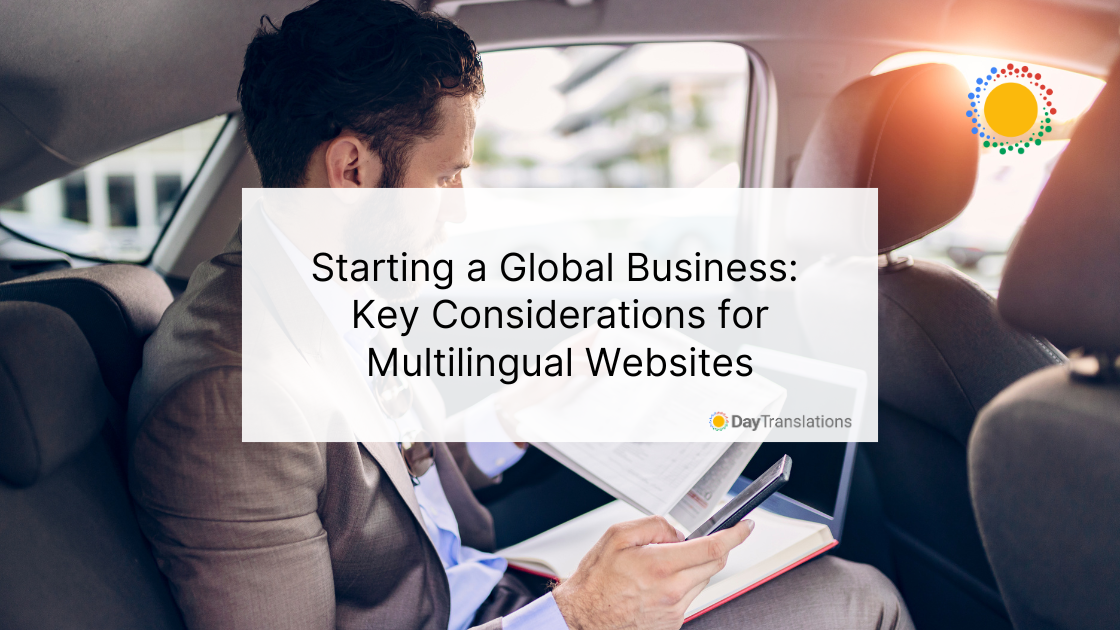Expanding your business internationally is an exciting opportunity to increase your market share and attract new customers. But if you’re starting a global business, one key aspect you can’t overlook is that your website needs to speak multiple languages. Having multilingual websites is essential to making a solid first impression and connecting with diverse audiences. But that’s not all you need.
Let’s take a closer look at what you should consider when starting a global business.
Get Clear on Your Customer Base’s Native Languages
Which countries are your target audiences in? Which countries do you currently have customers from? Are there any other international markets you’d like to expand to?
List every target country your website needs to cater to. Then, ensure you have features or versions that can adapt your website’s text to each language type. More on this in a bit.
Use a Global-Friendly Credit Card
When starting a business worldwide, it’s essential to manage international transactions well. Using a corporate credit card can help.
A business credit card helps you quickly pay for things like website building, marketing, and international partnerships.
Many also have features like expense tracking, fraud protection, and detailed reporting. These are all very helpful for managing money. Depending on the card you choose, you may also be able to pay in local currencies and customize spending limits to local markets with embedded policies.
Accept an Array of Payment Options
Give your international customers multiple payment options to reduce checkout abandonment and make buying easy.
Include options like PayPal, bank transfers, cash-on-delivery, credit cards, and local payment methods. Be sure to also include pay-later options, like Affirm or Sezzle. Some international banks, like Caixa, also offer these.
Provide Local Customer Support
Offer support in each customer’s native language if possible. Hire international contractors who speak different languages and are native speakers — they understand local markets and what makes customers tick.
Coach them on providing excellent customer service and ask them to use their knowledge of the local culture when talking to a user.
This helps personalize the customer support experience in every country you want to reach.
Protect Your Data
Since you’ll expose your business to multiple markets, there’ll be (unfortunately) more opportunities for cyberattacks.
If you use a cloud-based infrastructure for your multilingual website, don’t forget to protect data across regions. Consider using Data Security Posture Management (DSPM) to maintain compliance with international regulations and safeguard sensitive information effectively.
You can also use other security tools, such as password management software, biometric security, and two-factor authentication, to make it extremely difficult to hack your website.
For a robust security approach, hire a cybersecurity expert. They’ll check your risk level and give you security options to keep your business and website safe from global cyber attacks.
Add Currency and Language Modifiers to Your Website
Decide on the level of localization (entire website, specific pages, etc.) your website needs.
Then, use a Translation Management System (TMS) to let users change your website’s currency and language settings.
A TMS streamlines and manages content’s translation and localization process across different languages. It usually has features for arranging, automating, and tracking translations. It also has tools to help translators and project managers work together.
It’s also wise to use professional translators with experience in website localization. They understand cultural adaptation and nuance, so your text will match how people speak their native languages.
For instance, with our global network of 10,000 linguists, you can localize any website, page, or app — fast. Plus, we have a global staff and work around the clock. That means we’ll always respond to you in 10 minutes or less — any day of the year.
Here’s how our translation service works:
We follow a strict five-step review process to make sure your translations are always correct.
We back this promise with a lifetime guarantee.
- We start with a perfect translation to make sure the original meaning is preserved.
- A proofreader then checks the wording, grammar, spelling, and syntax.
- An editor then compares the original and translated text to make sure they align.
- Next, the Project Manager reviews the final version to ensure it meets your requirements.
- Finally, we deliver the completed text right away for your approval.
Want to learn more?
Get a quote or discuss your project with us now.
Have a Multilingual Social Media Strategy
Craft a multilingual social media strategy that resonates with your target customers.
Here are some quick tips to consider implementing:
Choose the Right Platforms
Not all social media platforms are popular everywhere. While Facebook and Instagram are major players in many regions, WeChat is essential in China, and VKontakte is vital in Russia.
Make sure you’re showing up on the platforms your international audience prefers.
Create Native Content
Simply translating your posts isn’t enough. Post content that feels natural in each language and considers cultural nuances and local expressions. Hiring native speakers or professional translators can help you get the tone right.
Engage with Local Trends
Stay up-to-date with what’s trending in each market. Whether it’s a local holiday, cultural event, or viral trend, weaving in these topics can make your brand more relatable and timely.
Schedule Posts Strategically
Time zones matter. Schedule your posts to go live when your target audience is most active. Tools like Planable or Buffer can efficiently help you manage posts across multiple time zones.
Monitor and Respond in Multiple Languages
Keep an eye on comments and messages in the languages you support. Respond promptly and thoughtfully in the same language. This shows that you value all of your social media followers equally.
Analyze and Optimize
Regularly review your performance metrics to see what’s working and what’s not. Be ready to adjust and adapt your social media marketing strategy based on engagement rates, follower growth, and other key indicators (like lead list-building metrics and conversions).
Wrap up
If you’re starting or transitioning to a global business, don’t overlook the power of a multilingual website.
With a global-friendly site, you’ll be able to reach more markets and create a pristine customer experience for your target audiences.
Here are some things to consider when creating a global business:
- Get clear on your customer base and their native languages
- Use a global-friendly credit card
- Accept a wide array of payment options (including local options)
- Provide local customer support
- Protect your data
- Add currency and language modifiers to your website
- Have a multilingual social media strategy
Ready to go global? Don’t forget to bookmark this and share it with decision-makers on your team.
And if you need a professional translation service — you know where to find us! Ask for a quote or speak to an expert now.
Here’s to your success!
Author Bio:
Kelly Moser is the co-founder and editor at Home & Jet, a digital magazine for the modern era. She’s also the content manager at Login Lockdown, covering the latest trends in tech, business and security. Kelly is an expert in freelance writing and content marketing for SaaS, Fintech, and ecommerce startups.












Sorry, the comment form is closed at this time.